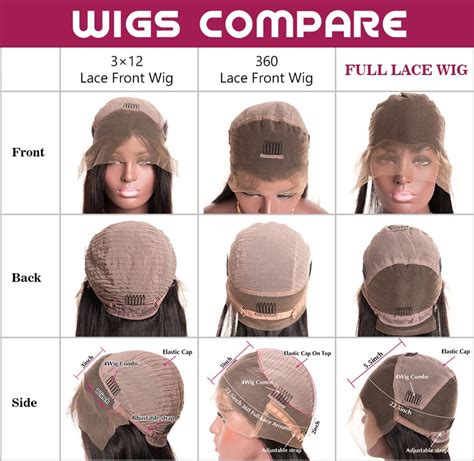Types of Wigs
Wigs come in a wide variety, offering endless options to transform your look. Understanding the different types can empower you to make informed choices that suit your needs and preferences.

Lace Front Wigs
- Swiss Lace Front Wig: Made with delicate, transparent lace, this wig seamlessly blends into the scalp for a natural appearance.
- HD Lace Front Wig: Features an even finer and more transparent lace, providing an almost invisible hairline.
- French Lace Front Wig: Known for its luxurious and durable lace, it offers a secure and comfortable fit.
Full Lace Wigs
- Full Lace Cap Wig: Covers the entire head with lace, allowing for complete versatility in styling and parting.
- 360 Lace Front Wig: Combines a full lace cap with a lace front, creating a 360-degree natural hairline.
Machine-Made Wigs
- Weft Wig: Constructed using wefts of hair sewn onto a breathable cap, offering a lightweight and airy feel.
- Monofilament Wig: Features a thin, lightweight base that simulates the natural scalp, enhancing the illusion of hair growth.
- Open Cap Wig: Allows for increased airflow, making it an ideal choice for those with sensitive scalps or in warm climates.
Synthetic Wigs
- Kanekalon Wig: Made from a heat-resistant synthetic fiber that can be heat-styled but cannot be dyed.
- Toyokalon Wig: Known for its soft and silky texture, offering a realistic and natural look.
- Human Hair Blend Wig: Combines natural human hair with synthetic fibers, offering a balance of affordability and durability.
Human Hair Wigs
- Remy Human Hair Wig: Uses intact cuticles aligned in the same direction, resulting in smooth, tangle-free hair.
- Virgin Human Hair Wig: Untreated and unprocessed hair sourced from a single donor, renowned for its exceptional quality and longevity.
- Yaki Human Hair Wig: Features a unique texturized surface that creates the appearance of natural African hair.
Common Mistakes to Avoid
- Choosing the Wrong Length or Density: Opt for a wig that complements your face shape and hair texture. Avoid wigs that are too long or too thick, which can overwhelm your features.
- Neglecting Customization: Wigs require customization to achieve the perfect fit and style. Consult a professional hair stylist to trim and shape the wig for a seamless blend.
- Over-Processing Human Hair Wigs: Human hair wigs can be dyed and styled, but excessive manipulation can damage the hair and shorten its lifespan.
- Improper Storage: Store wigs properly on a mannequin head or wig stand to prevent tangling and maintain their shape.
- Neglecting Maintenance: Regularly wash and condition wigs using specially formulated products to prolong their quality and appearance.
How to Choose the Right Wig
- Determine Your Hair Type: Consider your natural hair texture, density, and color when selecting a wig.
- Consider Your Face Shape: Choose a wig that frames your face and complements its shape.
- Decide on the Occasion: The type of wig you need depends on the occasion or purpose.
- Set a Budget: Determine the amount you’re willing to spend on a wig, keeping in mind that human hair wigs can be more expensive.
- Read Reviews: Check online reviews to gather insights into the quality and performance of different wigs.
Innovative Wig Applications
1. Medical Alopecia: Wigs provide a solution for hair loss caused by medical treatments or conditions.
2. Hair Transformation: Wigs offer the flexibility to experiment with different hairstyles and colors without committing to permanent changes.
3. Special Effects: Wigs play a crucial role in creating realistic characters for film, television, and cosplay.
4. Self-Expression: Wigs empower individuals to express their creativity and confidence by embracing unique styles.
5. Cultural Appropriation:** Wigs can facilitate cultural exchange by allowing individuals to explore different hairstyles associated with diverse cultures.
Table 1: Types of Lace Front Wigs
| Type | Lace Material | Features |
|---|---|---|
| Swiss Lace Front | Delicate and transparent | Seamless blend with scalp |
| HD Lace Front | Ultrathin and transparent | Virtually invisible hairline |
| French Lace Front | Luxurious and durable | Secure and comfortable fit |
Table 2: Types of Machine-Made Wigs
| Type | Cap Construction | Benefits |
|---|---|---|
| Weft Wig | Breathable cap with sewn-in hair wefts | Lightweight and airy |
| Monofilament Wig | Thin, lightweight base | Simulates natural scalp |
| Open Cap Wig | Air-circulating design | Ideal for sensitive scalps and warm climates |
Table 3: Types of Synthetic Wigs
| Type | Material | Features |
|---|---|---|
| Kanekalon Wig | Heat-resistant | Heat-styleable but cannot be dyed |
| Toyokalon Wig | Soft and silky | Realistic and natural look |
| Human Hair Blend Wig | Combination of human and synthetic fibers | Affordable and durable |
Table 4: Types of Human Hair Wigs
| Type | Quality | Features |
|---|---|---|
| Remy Human Hair Wig | Intact cuticles aligned in one direction | Smooth and tangle-free |
| Virgin Human Hair Wig | Untreated and unprocessed | Exceptional quality and longevity |
| Yaki Human Hair Wig | Unique texturized surface | Natural African hair appearance |
